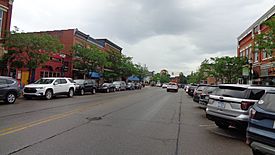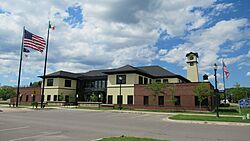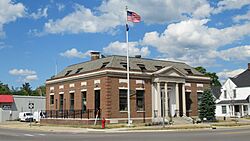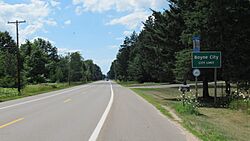Boyne City, Michigan facts for kids
Quick facts for kids
Boyne City, Michigan
|
|
|---|---|
| City of Boyne City | |

Looking east along Water Street in the Boyne City Central Historic District
|
|
| Motto(s):
"Where Life Meets Lake"
|
|

Location within Charlevoix County
|
|
| Country | |
| State | |
| County | Charlevoix |
| Settled | 1856 |
| Incorporated | 1885 (village) 1907 (city) |
| Government | |
| • Type | City commission |
| Area | |
| • Total | 5.34 sq mi (13.82 km2) |
| • Land | 3.98 sq mi (10.32 km2) |
| • Water | 1.35 sq mi (3.50 km2) |
| Elevation | 594 ft (181 m) |
| Population
(2020)
|
|
| • Total | 3,816 |
| • Density | 957.59/sq mi (369.77/km2) |
| Time zone | UTC−5 (Eastern (EST)) |
| • Summer (DST) | UTC−4 (EDT) |
| ZIP code(s) |
49712
|
| Area code(s) | 231 |
| FIPS code | 26-09820 |
| GNIS feature ID | 0621826 |
Boyne City (/bɔɪn/) is a city in Charlevoix County in the U.S. state of Michigan. The population was 3,816 at the 2020 census, making it the largest city in Charlevoix County. Boyne City is located at the eastern end of Lake Charlevoix, Michigan's third largest inland lake. The city is also the site of the mouth of the Boyne River, named for the River Boyne in Leinster, Ireland.
Contents
History
Boyne was first settled in 1856 and was given a post office in 1869. An inn was established here in 1879. Boyne was made a village in 1885. The name was changed to Boyne City in 1904 and it was incorporated as a city in 1907.
Geography
According to the United States Census Bureau, the city has a total area of 5.42 square miles (14.04 km2), of which 4.06 square miles (10.52 km2) is land and 1.36 square miles (3.52 km2) is water.
Climate
This climatic region has large seasonal temperature differences, with warm to hot (and often humid) summers and cold (sometimes severely cold) winters. According to the Köppen Climate Classification system, Boyne City has a humid continental climate, abbreviated "Dfb" on climate maps.
Transportation
Major highways
 M-75 curves and runs through the city.
M-75 curves and runs through the city. C-56 (Lake Street) is a county-designated highway that runs through the north portion of the city before terminating M-75.
C-56 (Lake Street) is a county-designated highway that runs through the north portion of the city before terminating M-75. C-73 (Boyne City Road) is a county-designated highway that enters the city briefly from the south and terminates at M-75.
C-73 (Boyne City Road) is a county-designated highway that enters the city briefly from the south and terminates at M-75.
Airport
 Boyne City Municipal Airport is a public use airport located in the city limits.
Boyne City Municipal Airport is a public use airport located in the city limits.
Railroad
 Boyne City Railroad was a railway company based in Boyne City from 1893 to 1978. Boyne City once contained its own train station along the larger Boyne City, Gaylord & Alpena Railroad.
Boyne City Railroad was a railway company based in Boyne City from 1893 to 1978. Boyne City once contained its own train station along the larger Boyne City, Gaylord & Alpena Railroad.
Demographics
| Historical population | |||
|---|---|---|---|
| Census | Pop. | %± | |
| 1890 | 450 | — | |
| 1900 | 912 | 102.7% | |
| 1910 | 5,218 | 472.1% | |
| 1920 | 4,284 | −17.9% | |
| 1930 | 2,650 | −38.1% | |
| 1940 | 2,904 | 9.6% | |
| 1950 | 3,028 | 4.3% | |
| 1960 | 2,797 | −7.6% | |
| 1970 | 2,969 | 6.1% | |
| 1980 | 3,348 | 12.8% | |
| 1990 | 3,478 | 3.9% | |
| 2000 | 3,503 | 0.7% | |
| 2010 | 3,735 | 6.6% | |
| 2020 | 3,816 | 2.2% | |
| U.S. Decennial Census | |||
2010 census
As of the 2010[update] census, there were 3,735 people, 1,635 households, and 1,011 families living in the city. The population density was 920.0 inhabitants per square mile (355.2/km2). There were 2,292 housing units at an average density of 564.5 per square mile (218.0/km2). The racial makeup of the city was 94.9% White, 0.4% African American, 0.7% Native American, 0.5% Asian, 0.1% Pacific Islander, 0.3% from other races, and 3.2% from two or more races. Hispanic or Latino of any race were 1.3% of the population.
There were 1,635 households, of which 29.8% had children under the age of 18 living with them, 43.8% were married couples living together, 13.1% had a female householder with no husband present, 4.9% had a male householder with no wife present, and 38.2% were non-families. 33.4% of all households were made up of individuals, and 14.8% had someone living alone who was 65 years of age or older. The average household size was 2.27 and the average family size was 2.85.
The median age in the city was 41.9 years. 23.9% of residents were under the age of 18; 7.5% were between the ages of 18 and 24; 22.6% were from 25 to 44; 29% were from 45 to 64; and 16.9% were 65 years of age or older. The gender makeup of the city was 48.5% male and 51.5% female.
Culture
Events
- Boyne City hosts the National Morel Mushroom Festival annually in May.
Sports
- Boyne City Boosters were a minor league baseball team that was part of the Michigan State League from 1911 to 1914.
Education
Boyne City is served entirely by its own school district, Boyne City Public Schools, which serves the city and large portions of several neighboring townships.
Notable people
- Charles Archibald Nichols, state politician who served in the U.S. House of Representatives, born in Boyne City
- John William Tebbel, journalist, editor, writer, teacher, and media historian who was born in Boyne City.
See also
 In Spanish: Boyne City para niños
In Spanish: Boyne City para niños






